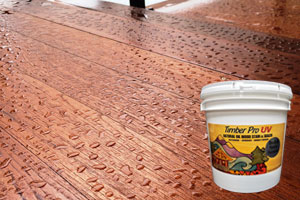Wood and Log Siding Maintenance Guide
Rule #1 – Keep It Clean
Rule #2 – Keep your Clear UV top coat fresh
Rule #3 – Don’t wait for finish to “wear off” before you re-apply
Maintaining natural wood siding is a lot easier if you dedicate a weekend once per year to cleaning the wood all the way around the house. The two culprits that contribute the most to finish degradation are dirt and sun. Dirt provides a food source for mold and mildew and the sun dries out the wood and fades the tint in the stain. A little preventative maintenance goes a long way and can save you a lot of time and money. If you don’t do some yearly maintenance on your log or wood-sided home you will end up having to strip off the finish and re-apply it again and that is a lot more work than just the preventative maintenance.
Transparent wood finishes do not contain significant amounts of tint or pigment like paint does. Everyone wants to maintain the natural wood look to be able to see the grain and beauty of the wood. Finishes that are very transparent need to be re-coated on an average of 1-3 years. The semi-transparent finishes or semi solid stains will last longer. If the siding is smooth, rather than rough sawn, it requires more frequent coating.
The design of the structure has a lot to do with how often you need to recoat as well. If the overhang is quite wide, or you have covered porches, the frequency of the maintenance coatings will be less. You may only need to treat every 3-7 years on more protected area’s of the building. There are no solid rules, nor exact duration as to when you will need to re-treat due to the type and porosity of the wood you used, how well the wood was saturated and number of coats when originally stained, whether you choose a transparent color, semi-trans, or semi-solid color, what the weather conditions are in your area, and how the siding is exposed in regards to the design of the structure.
Here are some tips that will help you to keep your siding beautiful year round.
Keep It Clean
Luckily Timber Pro UV is not a “dirt attracting” finish because it does not contain the soft, waxy oils that dirt wants to stick to. You could just actually hose off the siding with a strong jet spray every year and the dust will rinse away. If the home will be requiring a new coat of stain, do not use bleach based cleaners prior to staining. Our Clean & Brite Formula is designed to work with our products effectively. If you live in a more damp and mildew prone area, we suggest that you wash the home at least once a year with our Clean & Brite maintenance cleaner. It brightens the wood and removes any mold or mildew spores. If you use Clean & Brite you do not want to scrub really hard – just spray on the diluted solution, let it sit on the wood for 30 minutes or so (don’t let it dry out) and then hose it off with a strong spray or power wash it off at approximately 1200 psi. If it is really dirty you may want to lightly scrub with a soft bristle brush. If you know for sure that you are going to apply another coat of stain then definitely wash it with Clean & Brite which will wash off any live mildew spores that you may not see.
Monitor the Checks (especially with log homes)
There is not a finish made that will prevent the wood from forming small cracks or checks. If the siding was backprimed (sealed on the back side) it is less likely to warp and crack. Checks in the siding do not diminish its dimensional stability but if the check is large enough then there is a possibility that rain and moisture will fall down into the crack. On a regular basis, try to blow dust, cobwebs, etc. out of these cracks. If they are facing upwards and collecting rain then water can insinuate behind the finish and then push the stain off the log around the checks. Many siding professionals recommend filling the checks that are collecting rain with a high quality caulk and monitoring the sealant on a yearly basis to make sure it is not breaking away from the edges. On cracks and checks that are angling downward and won’t collect rain, it is recommended to try and spray Clear UV Timber Pro stain into these cracks to at least keep the inner walls of those cracks sealed up.
Keep the Clear UV coat fresh
Hopefully you applied that single top coat of Clear UV that we recommended initially. The Clear UV third coat helps to “lock in” the two color coats underneath which is why we recommend it. The last coat applied is always the first coat that wears off so it is better to lose a clear coat to the elements than a color coat. Once the Clear UV coat is applied you should definitely see “side sheen”, the low level gleam that you see when the sun hits the wood. Much of this gleam eventually dies down over the next six months as the product slow cures and sinks deeper into the wood. At some point, usually a year or two down the road there is no longer any sheen, the siding still have its color but the boards look a little dull and matte and this indicates that your top coat of clear coat has eroded away and should be re-applied. Wash the logs or siding with Clean & Brite before re-applying your Clear UV coat. Do not wash the wood with bleach, tsp, or any cleaning solution containing bleach or oxalic acid. Bleach is very hard on wood and causes fuzz. Oxalic acid causes problems with Timber-Pro UV and other finishes by making them turn gummy. If you notice that the color has faded after the washing process you should probably apply another color coat before re-applying the clear top coat. Once you have re-applied the top coat of Clear UV your side sheen should re-appear. If the siding still looks matte and dull then you are not applying heavy enough and need to apply more! If you still have sheen, do not apply another maintenance coat. If you apply product more often than is required and build up the Timber Pro UV so much it looks like varnish, it will not breathe as well as it should. You may notice that under your eaves or covered porches the finish has not worn at all. Do not apply a maintenance coat to the areas where the finish is not worn! Feather the finish into the first few inches of those areas and then stop. You must learn the art of maintaining the most weather exposed areas and feathering into the least exposed parts. This is required whatever brand of finish you have chosen.
Eventually, even if you’ve kept your top coat fresh, the sun will fade the color. At this point you may want to mix your original color in with some Clear UV to revive the color a little. Try a variety of ratios of colored stain blended with Clear UV to get the color just right to make them uniform in color with the non weather exposed walls.
Don’t wait for finish to wear off before you re-apply.
How do you know the finish has worn off? Well, Timber-Pro UV only wears off the surface fibers the oil resin is still inside the wood protecting from water absorption. When the tint has eroded completely the wood will turn very creamy pale color. If this happens you’ll know you waited too long. Soon after that, it will turn pale gray. It may only gray in narrow strips, where the flattest grain is. This is nature – stains don’t absorb as well on the flat grain. You will have to remove that gray before re-applying another color coat and then a coat of Clear UV over that.
Hopefully, the Clean & Brite will remove the gray. If not, you will have to use Strip & Brite to completely remove it and the rest of the stain, and start over. Incidentally, if you noticed gray streaks on your siding boards when they were new and clean, it is possible that your siding contained blue stain fungi, prevalent on many species of pine, and sometimes cedar and fir. . Blue stain is not dangerous, and does not hurt the integrity of the wood but these stains cannot be removed with cleaners because they are an integral part of the wood and the bluish gray stain goes all the way through to the center of the board.
Snow in your area?
Snow which is allowed to pile up against wood siding can really affect the wood finish durability. Snow allowed to touch the wood suffocates the wood with water so the wood and the finish cannot breathe. The melting snow will insinuate into the tiny checks and cracks in the wood finding its way behind the finish. This constant wetting may rehydrate the finish which will dramatically dilute it and the finish will move so deep into the wood that it will look like it has completely worn off sometimes. Keep snow away from the logs and/or siding.
In conclusion:
Now you better understand the importance of preventative maintenance. Cleaning and touching up is so much easier when you have been consistent from year to year. Don’t hesitate to call us when you are unsure about how to proceed.
Questions? Call Timber-Pro UV Wood Finishes for technical support.
Toll free at (888) 888-6095 or locally in Portland, OR (503) 232-1705




